The x86 Power Myth Busted: In-Depth Clover Trail Power Analysis
by Anand Lal Shimpi on December 24, 2012 5:00 PM ESTThe untold story of Intel's desktop (and notebook) CPU dominance after 2006 has nothing to do with novel new approaches to chip design or spending billions on keeping its army of fabs up to date. While both of those are critical components to the formula, its Intel's internal performance modeling team that plays a major role in providing targets for both the architects and fab engineers to hit. After losing face (and sales) to AMD's Athlon 64 in the early 2000s, Intel adopted a "no more surprises" policy. Intel would never again be caught off guard by a performance upset.
Over the past few years however the focus of meaningful performance has shifted. Just as important as absolute performance, is power consumption. Intel has been going through a slow waking up process over the past few years as it's been adapting to the new ultra mobile world. One of the first things to change however was the scope and focus of its internal performance modeling. User experience (quantified through high speed cameras mapping frame rates to user survey data) and power efficiency are now both incorporated into all architecture targets going forward. Building its next-generation CPU cores no longer means picking a SPECCPU performance target and working towards it, but delivering a certain user experience as well.
Intel's role in the industry has started to change. It worked very closely with Acer on bringing the W510, W700 and S7 to market. With Haswell, Intel will work even closer with its partners - going as far as to specify other, non-Intel components on the motherboard in pursuit of ultimate battery life. The pieces are beginning to fall into place, and if all goes according to Intel's plan we should start to see the fruits of its labor next year. The goal is to bring Core down to very low power levels, and to take Atom even lower. Don't underestimate the significance of Intel's 10W Ivy Bridge announcement. Although desktop and mobile Haswell will appear in mid to late Q2-2013, the exciting ultra mobile parts won't arrive until Q3. Intel's 10W Ivy Bridge will be responsible for at least bringing some more exciting form factors to market between now and then. While we're not exactly at Core-in-an-iPad level of integration, we are getting very close.
To kick off what is bound to be an exciting year, Intel made a couple of stops around the country showing off that even its existing architectures are quite power efficient. Intel carried around a pair of Windows tablets, wired up to measure power consumption at both the device and component level, to demonstrate what many of you will find obvious at this point: that Intel's 32nm Clover Trail is more power efficient than NVIDIA's Tegra 3.
We've demonstrated this in our battery life tests already. Samsung's ATIV Smart PC uses an Atom Z2760 and features a 30Wh battery with an 11.6-inch 1366x768 display. Microsoft's Surface RT uses NVIDIA's Tegra 3 powered by a 31Wh battery with a 10.6-inch, 1366x768 display. In our 2013 wireless web browsing battery life test we showed Samsung with a 17% battery life advantage, despite the 3% smaller battery. Our video playback battery life test showed a smaller advantage of 3%.

For us, the power advantage made a lot of sense. We've already proven that Intel's Atom core is faster than ARM's Cortex A9 (even four of them under Windows RT). Combine that with the fact that NVIDIA's Tegra 3 features four Cortex A9s on TSMC's 40nm G process and you get a recipe for worse battery life, all else being equal.
Intel's method of hammering this point home isn't all that unique in the industry. Rather than measuring power consumption at the application level, Intel chose to do so at the component level. This is commonly done by taking the device apart and either replacing the battery with an external power supply that you can measure, or by measuring current delivered by the battery itself. Clip the voltage input leads coming from the battery to the PCB, toss a resistor inline and measure voltage drop across the resistor to calculate power (good ol' Ohm's law).
Where Intel's power modeling gets a little more aggressive is what happens next. Measuring power at the battery gives you an idea of total platform power consumption including display, SoC, memory, network stack and everything else on the motherboard. This approach is useful for understanding how long a device will last on a single charge, but if you're a component vendor you typically care a little more about the specific power consumption of your competitors' components.
What follows is a good mixture of art and science. Intel's power engineers will take apart a competing device and probe whatever looks to be a power delivery or filtering circuit while running various workloads on the device itself. By correlating the type of workload to spikes in voltage in these circuits, you can figure out what components on a smartphone or tablet motherboard are likely responsible for delivering power to individual blocks of an SoC. Despite the high level of integration in modern mobile SoCs, the major players on the chip (e.g. CPU and GPU) tend to operate on their own independent voltage planes.
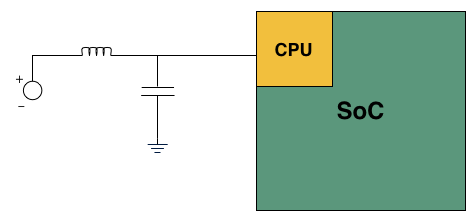
A basic LC filter
What usually happens is you'll find a standard LC filter (inductor + capacitor) supplying power to a block on the SoC. Once the right LC filter has been identified, all you need to do is lift the inductor, insert a very small resistor (2 - 20 mΩ) and measure the voltage drop across the resistor. With voltage and resistance values known, you can determine current and power. Using good external instruments you can plot power over time and now get a good idea of the power consumption of individual IP blocks within an SoC.
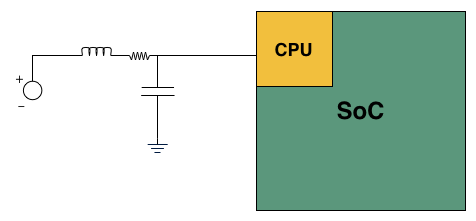
Basic LC filter modified with an inline resistor
Intel brought one of its best power engineers along with a couple of tablets and a National Instruments USB-6289 data acquisition box to demonstrate its findings. Intel brought along Microsoft's Surface RT using NVIDIA's Tegra 3, and Acer's W510 using Intel's own Atom Z2760 (Clover Trail). Both of these were retail samples running the latest software/drivers available as of 12/21/12. The Acer unit in particular featured the latest driver update from Acer (version 1.01, released on 12/18/12) which improves battery life on the tablet (remember me pointing out that the W510 seemed to have a problem that caused it to underperform in the battery life department compared to Samsung's ATIV Smart PC? it seems like this driver update fixes that problem).
I personally calibrated both displays to our usual 200 nits setting and ensured the software and configurations were as close to equal as possible. Both tablets were purchased by Intel, but I verified their performance against my own review samples and noticed no meaningful deviation. All tests and I've also attached diagrams of where Intel is measuring CPU and GPU power on the two tablets:

Microsoft Surface RT: The yellow block is where Intel measures GPU power, the orange block is where it measures CPU power
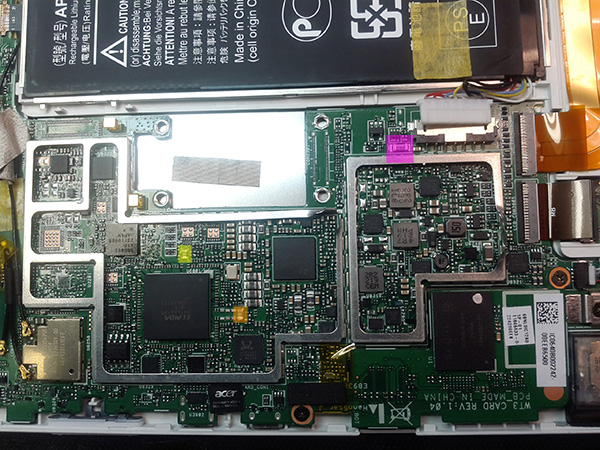
Acer's W510: The purple block is a resistor from Intel's reference design used for measuring power at the battery. Yellow and orange are inductors for GPU and CPU power delivery, respectively.
The complete setup is surprisingly mobile, even relying on a notebook to run SignalExpress for recording output from the NI data acquisition box:
Wiring up the tablets is a bit of a mess. Intel wired up far more than just CPU and GPU, depending on the device and what was easily exposed you could get power readings on the memory subsystem and things like NAND as well.
Intel only supplied the test setup, for everything you're about to see I picked and ran whatever I wanted, however I wanted. Comparing Clover Trail to Tegra 3 is nothing new, but the data I gathered is at least interesting to look at. We typically don't get to break out CPU and GPU power consumption in our tests, making this experiment a bit more illuminating.
Keep in mind that we are looking at power delivery on voltage rails that spike with CPU or GPU activity. It's not uncommon to run multiple things off of the same voltage rail. In particular, I'm not super confident in what's going on with Tegra 3's GPU rail although the CPU rails are likely fairly comparable. One last note: unlike under Android, NVIDIA doesn't use its 5th/companion core under Windows RT. Microsoft still doesn't support heterogeneous computing environments, so NVIDIA had to disable its companion core under Windows RT.


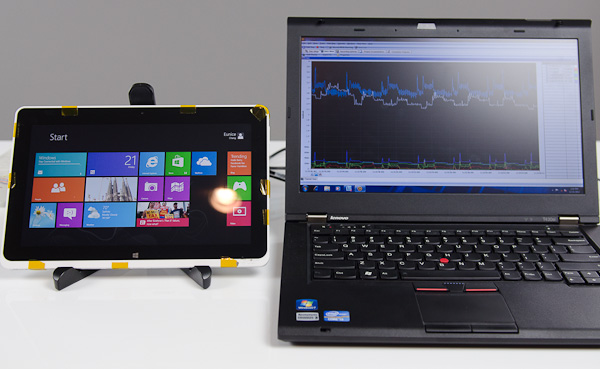
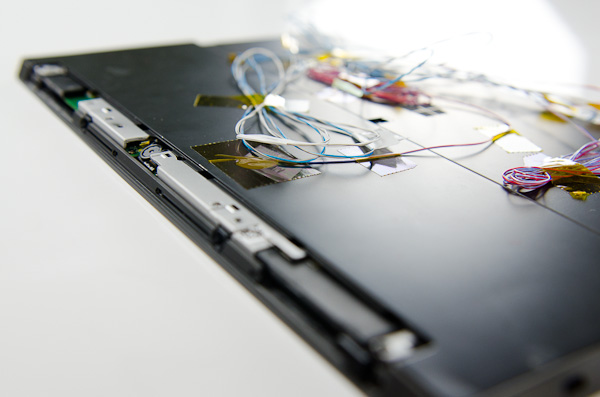
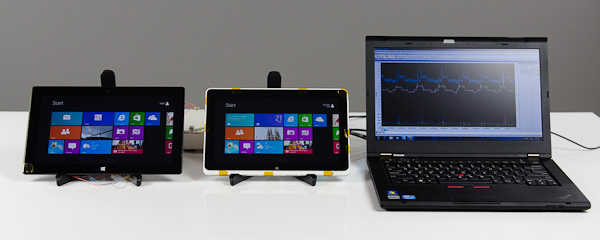














163 Comments
View All Comments
Veteranv2 - Friday, December 28, 2012 - link
You mean on Win8 right?You take a bloated x86 optimized OS with crappy ARM support and you compare it to the best x86 chip maker.
Great... Happy world you live in.
Braumin - Friday, December 28, 2012 - link
Um, smart ass. Medfield was running Android.And Windows 8/RT is far from bloated. Good try though.
jwcalla - Saturday, December 29, 2012 - link
Unfortunately we can't draw too many conclusions about Win8 vs. RT since we can't look at the code base. Especially for benchmarks like "cold boot". The manner of bringing up devices is likely rather distinct.And, unfortunately, we don't know anything about the compilers used for the software either.
Now a compiler like GCC can give us some broad ideas... we can test and see that, in general, it compiles code to an x86 target more efficiently than to ARM architectures... and this isn't particularly surprising since x86 has years upon years of optimizations built into it (GCC). Not to mention that some software will have better x86 optimizations also (this is typical; developing for ARM does require different software implementation methods for optimizations).
But we don't know much of anything about Windows code or compilers since it's kind of closed up. But, in theory, 8 vs. RT shouldn't be line-by-line identical... or that would be a job poorly done.
We can only draw some non-specific conclusions that the two are in the same field of range, and that's all that matters from a user experience perspective anyway. (Or, at least, this particular x86 implementation vs. that particular ARM implementation are relatively close in terms of performance and power efficiency.)
mrtanner70 - Thursday, December 27, 2012 - link
A little more journalistic push back would go a long way. In Intel's eyes they have co-opted you Anand, it's a clear strategy on their behalf, they know you are influential.A brand new atom should not be solely compared with an aging Tegra. I have no problem with the companion core issue given RT does not use it, but a Krait RT product, or Ipad (despite the o/s issue) would have been a much more apples to apples comparison in terms of chip generation. If this article had included one or both of those in addition to the Tegra3 it would have been vastly more credible.
You have the power to push back for the best comparison YOU, not Intel, can think of.
Braumin - Thursday, December 27, 2012 - link
Brand new Atom and aging Tegra 3? The Atom CPU is the same CPU with minor tweaks that was first introduced 5 YEARS ago.The Tegra 3 is a chip that is barely a year old... and still on sale today.
Anand will test a Krait tablet when they are available. Right now there are none. That alone makes this a fair comparison.
And there will be a new Atom next year. When the Krait comes out on a Windows RT tablet, should we then hold off until the new Atom comes out before we do comparisons, or should we compare PRODUCTS YOU CAN BUY RIGHT NOW? I mean both of these devices are new products in the last two months. How is this not relevant?
I mean seriously. These comments are disgusting I used to think most Anandtech readers were tech savvy, but that's obviously not the case anymore.
jwcalla - Thursday, December 27, 2012 - link
The problem with most hardware sites, this one not excluded, is that they seem to be unconcerned about the software influences on these comparisons.Now I love Anand but he's just as guilty in this point in many of the reviews he posts. He'll have a SunSpider benchmark of this platform vs. that platform and then draw conclusions about the hardware, which you just simply cannot do. Such a benchmark allows you to draw conclusions about the entire system only. Now that's definitely important from the perspective of a product review where, ultimately, only the user experience matters. But you can't draw conclusions about A6X vs. Samsung Dual or whatever based on a benchmark run on completely different software stacks.
Likewise, measuring differences in the cold boot process of Surface RT vs. Surface Pro doesn't really tell us... anything... about the hardware at least. Just a cursory understanding of computers explains to us why that is.
However, the goal of this article is to show that Intel can make a chip that plays in the same ballpark as ARM's Cortex-A9s. I'm not sure that that actually establishes anything significant though, since Intel is clearly the challenger in this market... and showing up isn't enough to get wins -- as Anand points out. But it's also what we already knew: when you scale back performance and simplify the instruction set, you get lower power usage.
kyuu - Thursday, December 27, 2012 - link
I think Win8 vs. WinRT are as close as your going to get software-wise between an ARM-system vs. an x86-system.mrtanner70 - Thursday, December 27, 2012 - link
While the underlying architecture is not new, clover trail absolutely is. It just started showing up in shipping devices. It's a comparison designed to be the most favorable one possible for Intel, and a good journalist would push for the best one period. You have an odd definition of disgusting.jwcalla - Thursday, December 27, 2012 - link
To me these results don't even begin to provide a compelling motivation for Apple or Samsung (e.g.) to drop their own designs (and in the latter case, fabs) for Intel in their products. Why introduce a third-party to your supply chain for what amounts to differences that are almost entirely in the noise? (And can easily be caused by measuring errors, software differences, compiler advantages, etc.)The only real plus that Intel brings to the table is for the Windows folks who are enamored with the idea of running XP apps on their phones. But there aren't enough of these people to turn the tide in a market where ARM clearly has a stronghold.
However, Intel should be successful at stemming any losses in the ultrabook or server markets.
kyuu - Thursday, December 27, 2012 - link
There aren't a whole lot of people who care about running x86 apps on their phone, true. However, there are lot of people who would like to run x86 apps on their tablets.